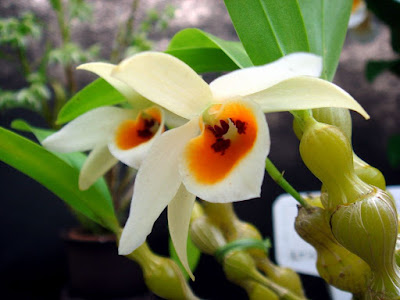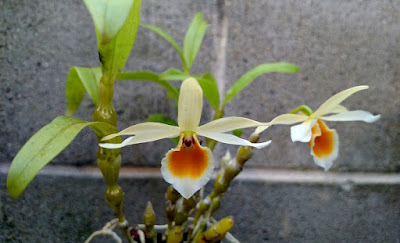Dendrobium aphrodite is native to Tennasserim range in Myanmar and Thailand. It grows in the top of the tallest trees at elevations around 1400 meters above sea level.
Dendrobium aphrodite also called as The Beautiful Dendrobium, Callista aphrodite, Dendrobium nodatum, is a species of the genus Dendrobium. This species was described by Heinrich Gustav Reichenbach in 1862.
IDENTIFY DENDROBIUM APHRODITE ORCHID PLANT
Dendrobium aphrodite is native to Tennasserim range in Myanmar and Thailand. It grows in the top of the tallest trees at elevations around 1400 meters above sea level.
It is a small to medium sized, cool growing epiphyte which reaching 30 cm long with slender, branching, suberect stems that are strongly swollen at the nodes carrying a few, oblong-obtuse, deciduous, 10 cm long leaves.
The Beautiful Dendrobium in the spring on an axillary, 1 to 2 flowered inflorescence with delicately fragrant flowers that arises from the upper leaf nodes of leafless canes and can produce for several seasons. Sepals and petals are white. The labellum is large and spreading, the front lobe being golden yellow with a white disk on the claw, and white margins, the sides curl inwards, and there is a deep blood-red spot at the base.
DENDROBIUM APHRODITE ORCHID PLANT CARE AND CULTURE
Cultural information should only be used as a guide, and should be to be adapted to suit you. Your physical location; where you grow your plants, how much time you have to devote to their care, and many other factors, will need to be taken into account. Only then can you decide on the cultural methods that best suit you and your plants.
Light:
Dendrobium aphrodite like plenty of light, but cannot stand the full noonday rays of the sun (15000-40000 lux, filtered or diffused light is recommended.). These usually do best when placed so that they can get the early morning sun, but are shaded from about 10 a.m. onwards in the Summer time. In the Winter they can usually stand the sun's rays up to 11.30 a.m.
Temperature:
The average temperature of the summer day is 30-32 ° C, night 22 ° C, giving a daily difference of 8-9 ° C. In winter the average day temperature is 28-31 ° C, night 11-13 ° C, giving a daily difference of 15-18 ° C.
Humidity:
From summer to autumn, The Beautiful Dendrobium need the humidity of 80-85%, but for most of the remaining period it drops to 60-70%. Too dry air has a negative effect on the development of the plant: its growth is inhibited, and the leaves begin to turn yellow and dry out. The higher temperature, the higher the humidity should be, and the higher the humidity, the more often and longer it is necessary to ventilate the room where the plants are contained, otherwise the probability of rotting and various kinds of fungal diseases.
Substrate, growing media and repotting:
Dendrobium aphrodite grows best in wooden baskets with staghorn peat as substrate (line the bottom with a few large pieces of wood-charcoal, which helps to provide aeration, and counteracts any tendency of the compost to ferment). The pseudobulbs can be tied, where necessary, to the hanging wires, thus ensuring stability.
Watering:
The Beautiful Dendrobium will require heavy watering until well into the Autumn, the plants then being allowed to dry out for the Winter, except for a soaking about once in four to six weeks. Watering is directly dependent on the temperature of the content, the higher it is, the more often it needs to be watered. When watering, excess water should flow freely from the pot, since stagnation of water both inside the pot and in its pan can very quickly lead to rotting of the roots and the lower part of the plant.
Fertilizer:
It is recommended to use a 1/4-1/2 dose of orchid fertilizer weekly. You can use the balanced fertilizer throughout the year or from spring to mid-summer use high-nitrogen fertilizer, and then until the end of autumn high-phosphoric fertilizer to stimulate flowering.
Rest period:
Dendrobium aphrodite need less water in the winter, especially if they grow under the conditions of a dark, short day that occurs at moderate latitudes. They should dry somewhat between waterings, but they should not be dry for a longer period. Frequent morning fogging and rare, economical watering should allow the plant to go through a dry period of rest, while providing it with sufficient humidity. Fertilization should be reduced or eliminated until new growths appear and a more abundant spring watering begins.















COMMENTS